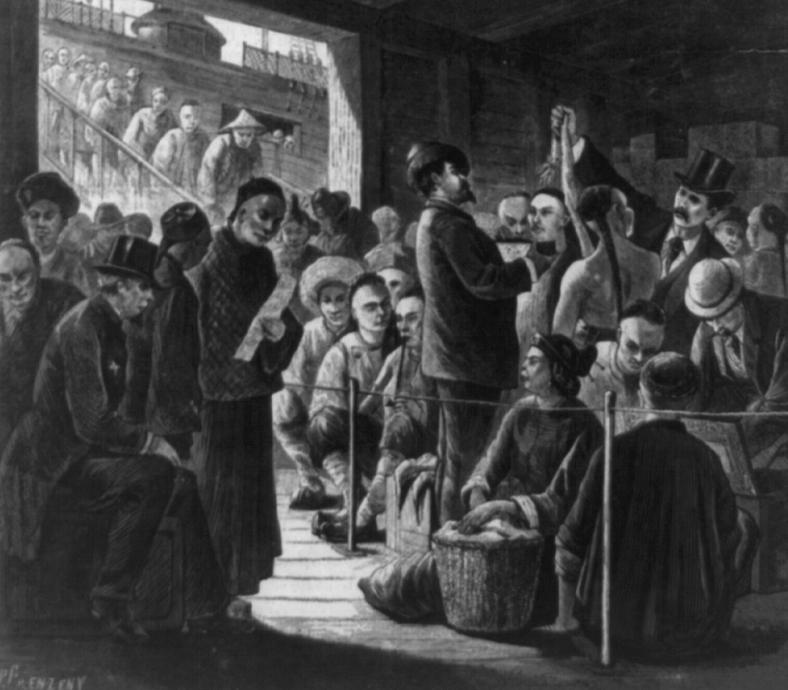 The NYPR Archive Collections
The NYPR Archive Collections
Episode 16 Orientals in the United States

Taken from the Dept. of the Interior, Office of Education study guide:
THE ORIENTALS
The Chinese can read the wisdom of his ancestors back to the time when the ancestors of most Americans were in the woods throwing stone hatchets at each other.—FINLEY PETER DUNNE.
Although the first Chinese immigrant about whom anything is known was admitted in 1820, only eighty-eight Chinese arrived during the next thirty years. The Chinese were not an adventurous people. At first, because their customs were different, they did not find a ready welcome here. Then, in 1849, something happened which changed the whole picture.
Gold was struck in California.
The Forty-Niners. To San Francisco came adventurers and gold seekers from all parts of the world. Where our ships had previously brought goods from China, they now brought Chinese laborers. Men were needed to dig in the mines, to cook food, to wash clothes, and to do housework, The Chinese were used to hard work, they needed little food, and they found the pay good. About 20,000 of them arrived in 1852 and 13,000 in 1854. Railroad Workers. In the 1860's the Chinese were once more in demand. At the end of the War between the States, the work of completing the first transcontinental railroad was rapidly pushed forward. On the Union Pacific Railroad, building westward from Omaha, were the Irish and other workers. On the Central Pacific Railroad, building eastward through the mountains, nine out of every ten of the workers were Chinese. It was one of the most dramatic moments in American history when the two roads met at Promontory Point, Utah, in 1869. - From this time on, the Chinese filtered eastward to our great cities where they took up different occupations. Their numbers gradually increased, 40,000 being admitted in 1882, most of whom settled along the West Coast.
As a result of this increase in the number of Chinese immigrants, Congress, in 1882, suspended Chinese immigration for ten years. This suspension was later renewed and practically excluded the Chinese. Their numbers have decreased from 107,000 in 1890 to about 75,000 in 1938. They are industrious, law abiding and home loving, and have contributed a picturesque element to the United States.
THE JAPANESE
*Etiquette" is Oriental in its origin. Japan shares with Persia, China, and the Caliphate of Bagdad, the honor of having been the seat of culture and cultivated manners-LILLIAN EICHLER. Until 1854, outsiders had been completely barred from Japan for more than three hundred years. Then, in that year, Commodore Matthew Perry of the United States Navy visited Japan and opened trade relations between the two countries.
The Japanese Arrive.
It was in the late eighties, several years after the law suspending Chinese immigration had been passed, that the Japanese began to arrive. Even then, they came in very small numbers at first. During the nineties, Japanese immigrants gradually increased until a total of nearly 13,000 arrived in 1900. Practically all the newcomers settled in California. As a result, vigorous protests were made by Labor Unions and other organizations. Shortly after this, the United States reached what is commonly referred to as a Gentlemen's Agreement with Japan in 1907. By the terms of the Agreement, Japan was not to issue passports to skilled or unskilled workers who wished to come to the United States. Of its own accord, Japan included Canada and Mexico in this arrangement so as to keep the spirit as well as the letter of the Agreement. Between 1907 and 1920, nearly 13,000 Japanese arrived and almost the same number departed for Japan. By 1920, however, California was again stirred up because of "picture brides." This was the practice of arranging marriages between Japanese in this country and women who lived in Japan. Again Japan cooperated and put an end to the practice.
What They Did.
The Japanese came to this country because of the opportunities which this country offered. Where the Chinese became city dwellers, scattered throughout the United States, the Japanese became farmers and rural workers. Most of them settled along the Pacific Coast. Today, there are less than 140,000 Japanese in this country. Most of them are engaged in raising and marketing fruit and vegetables. Many, too, are expert fishermen. Their work in reclaiming land in the Imperial Valley and in irrigating sandy areas has won them the respect and admiration of those who understand the problems they have had to solve.
WNYC archives id: 125539